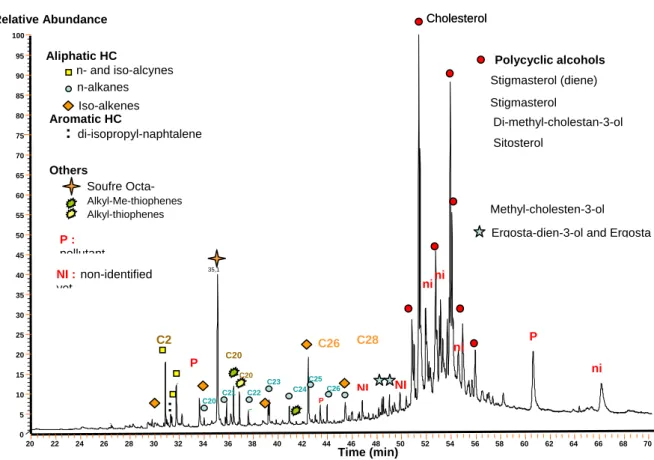HAL Id: hal-00094819
https://hal-insu.archives-ouvertes.fr/hal-00094819
Submitted on 15 Sep 2006HAL is a multi-disciplinary open access
archive for the deposit and dissemination of sci-entific research documents, whether they are pub-lished or not. The documents may come from teaching and research institutions in France or abroad, or from public or private research centers.
L’archive ouverte pluridisciplinaire HAL, est destinée au dépôt et à la diffusion de documents scientifiques de niveau recherche, publiés ou non, émanant des établissements d’enseignement et de recherche français ou étrangers, des laboratoires publics ou privés.
Calibration of organic signal in sedimentary lacustrine
records. Molecular comparison between actual
producers, dissolved organic matter and sedimentary
organic matter (Lac Pavin; Massif Central Français)
Mohammed Boussafir, Sylvain Drouin, Jean-Louis Robert, Patrick Albéric
To cite this version:
Mohammed Boussafir, Sylvain Drouin, Jean-Louis Robert, Patrick Albéric. Calibration of organic signal in sedimentary lacustrine records. Molecular comparison between actual producers, dissolved organic matter and sedimentary organic matter (Lac Pavin; Massif Central Français). IMOG, 2005, Seville, Spain. 2p. �hal-00094819�
Calibration of organic signal in sedimentary lacustrine records.
Molecular comparison between actual producers, dissolved
organic matter and sedimentary organic matter (Lac Pavin;
Massif Central Français)
M. Boussafir, S. Drouin, J.L. Robert et P. Albéric
ISTO (UMR 6113, CNRS - Université d’Orléans), Bâtiment Géosciences, Rue de Saint Amand, BP. 6759, 45067 Orléans Cedex 2, France
Paleoenvironmental studies undertaken in the past few years on lacustrine sediments indicate highly complex organic records. Indeed, the organic sources in lacustrine environments are numerous and early diagenetic transformations further complicate the molecular signal. This diagenetic filter can sometimes mask environmental information (by degradation of organic source biomarkers) as well as revealing it by purification of the signal (information on condition of sedimentary organic matter (SOM) incorporation). The preliminary calibration between primary producers and organic matter in sediments is essential in order to understand the processes prevailing in deposition and preservation of sedimentary organic material.
The main objective of this work is to study and compare the composition of lipid fractions contained in primary producers and those preserved in recent sediments. This work forms part of a project aimed at understanding the role of the minerals especially clays in the transfer and the preservation of hydrocarbon-rich SOM (S. Drouin et al. this meeting).
Specific information obtained on molecular composition of the primary producers, dissolved organic matter, through to SOM compositions will aid elucidation of the evolution and fate of OM, and allow determination of organic species susceptible to clay mineral adsorption i.e. those likely to escape organic recycling.
GC/MS analysis was carried out on the extracted lipids of the following:
• Living lacustrine organisms (2 samples). These are Macrophytes algae existing at the sediment-water column interface at depths of 2-10m, and phytoplanktonic algae. • 5 litre water aliquots (10 samples), collected in various depths in the lake.
• Greenish surface sediments collected on the first 15 cm of a small sedimentary core (1 sample, figure 1).
• Brownish sediment at a more advanced stage of diagenesis (1 sample) representing the oldest part (15-30 cm) of the previous sediment core.
Preliminary results show that the extractable lipids of these various studied fractions are dominated by a remarkable diversity of alcohols, particularly polycyclic moieties. The Macrophytes algae and phytoplanktonic algae present the same molecular signatures with different relative proportions. Some of these lipid fractions are found in the dissolved organic matter and in recent sediments bearing signs of oxidative deterioration witnessing the transfer of OM through the water column.
The lipid composition of dissolved organic matter in the anoxic water column is richer and better-preserved compared to lipids in the oxygenated water column. The molecular comparison of the green recent sediment, and the brown older, deeper sample highlights the molecular transformations typifying this diagenetic sequence, with increasing amounts of some aliphatic compounds and the disappearance of few molecular families entirely.
Figure 1 : Total ion currents of neutral lipid fraction of greenish surface sediment sample
20 22 24 26 28 30 32 34 36 38 40 42 44 46 48 50 52 54 56 58 60 62 64 66 68 70 0 5 10 15 20 25 30 35 40 45 50 55 60 65 70 75 80 85 90 95 100 Relative Abundance 35,1 n- and iso-alcynes n-alkanes Iso-alkenes Aliphatic HC
Ergosta-dien-3-ol and Ergosta
Polycyclic alcohols : di-isopropyl-naphtalene : Aromatic HC C2 P: pollutant P Soufre Octa-Others C21 C24 Alkyl-Me-thiophenes C20 Alkyl-thiophenes C20 C20 C22 C23 C26 C25 P C26 C28 Cholesterol P Cholesterol Di-methyl-cholestan-3-ol Methyl-cholesten-3-ol Sitosterol Stigmasterol (diene) Stigmasterol NI:non-identified yet ni ni ni NI NI ni Time (min)
